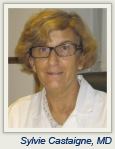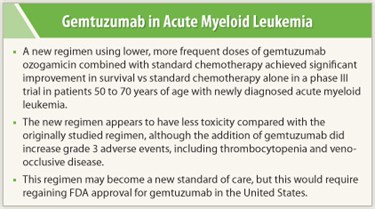A study presented at the Plenary Session of the 53rd Annual Meeting of the American Society of Hematology (ASH) breathes new life into an older drug for acute myeloid leukemia (AML) that is no longer available in the United States.1 Gemtuzumab ozogamicin (Mylotarg) appears to be a promising therapeutic option for older patients with acute myeloid leukemia with favorable cytogenetics when used in relatively low, frequently repeated doses, according to results of the Acute French Leukemia Association (ALFA) phase III trial.
New Dosing Regimen
 “Research has demonstrated that [gemtuzumab] has very potent anticancer properties, and with this study, we have identified a dosing regimen that gives patients the therapeutic benefit of the drug without some of the toxicities reported at higher doses,” stated lead author Sylvie Castaigne, MD, Professor in the Department of Hematology at Hôpital de Versailles, Versailles, France. “The standard of care has been daunorubicin plus cytarabine for many years. There hasn’t been a new therapeutic option for several decades, and with this research we are encouraged that [gemtuzumab] may be able to improve overall outcomes for these AML patients with limited alternatives.”
“Research has demonstrated that [gemtuzumab] has very potent anticancer properties, and with this study, we have identified a dosing regimen that gives patients the therapeutic benefit of the drug without some of the toxicities reported at higher doses,” stated lead author Sylvie Castaigne, MD, Professor in the Department of Hematology at Hôpital de Versailles, Versailles, France. “The standard of care has been daunorubicin plus cytarabine for many years. There hasn’t been a new therapeutic option for several decades, and with this research we are encouraged that [gemtuzumab] may be able to improve overall outcomes for these AML patients with limited alternatives.”
Gemtuzumab is an anti-CD33 antibody conjugated with a toxin; the antibody binds to the surface of CD33-positive leukemia cells and releases the toxin (ie, chalicheamicin) into the leukemia cells. The antibody is specifically targeted to the leukemia cells and theoretically spares toxicity to other cells that don’t express CD33.
Gemtuzumab was withdrawn from the U.S. market in June 2010, after a clinical trial demonstrated that the drug increased mortality and added no benefit over conventional therapies for AML.
Study Results
The phase III, prospective, open-label, randomized trial enrolled 280 newly diagnosed de novo AML patients aged 50 to 70 years. A regimen of 3 mg/m2 gemtuzumab IV on days 1, 4, and 7 was designed to give lower but repeated doses that might enhance gemtuzumab’s efficacy and minimize hepatic and hematologic toxicities reported earlier with this antibody. Patients were randomly assigned to arm A (standard daunorubicin plus cytarabine) or arm B (the same chemotherapy plus the gemtuzumab regimen). Those who achieved remission on two cycles of treatment received two courses of consolidation therapy with the same treatments. Patients with persistent bone marrow blasts at day 15 after the first induction course received a second cycle of treatment, which was given without additional doses of gemtuzumab.
 The experimental arm extended event-free survival by just under 8 months. At 2 years, median event-free survival was 11.9 months with standard therapy vs 19.6 months with the addition of gemtuzumab, a result that was highly significant (P = .00018). The addition of gemtuzumab also extended overall survival: Median overall survival was 19.2 months with standard chemotherapy vs 34 months with chemotherapy plus gemtuzumab (P = .046).
The experimental arm extended event-free survival by just under 8 months. At 2 years, median event-free survival was 11.9 months with standard therapy vs 19.6 months with the addition of gemtuzumab, a result that was highly significant (P = .00018). The addition of gemtuzumab also extended overall survival: Median overall survival was 19.2 months with standard chemotherapy vs 34 months with chemotherapy plus gemtuzumab (P = .046).
Improvement in event-free and overall survival was not observed in the subset of patients with unfavorable cytogenetics, Dr. Castaigne said. The rate of fatal events was higher in the experimental arm: 6.7% with standard therapy vs 8.7% in the arm that included gemtuzumab. In the experimental arm, prolonged grade 3 thrombocytopenia was reported in 19 patients and veno-occlusive disease or sinusoidal obstructive syndrome was seen in 3 patients (2 cases were fatal). No differences were observed between the two treatment arms in the rate of severe sepsis or intensive care admission during therapy. ■
Disclosure: Sylvie Castaigne received consultant fees from Wyeth from 2006 to 2008.
Expert Point of View: Is Gemtuzumab a Therapeutic Option in Older Patients with Acute Myeloid Leukemia?
Reference
1. Castaigne S, Pautas C, Terre C, et al: Fractionated doses of gemtuzumab ozogamicin (GO) combined with standard chemotherapy improves event-free survival in newly-diagnosed de novo AML patients aged 50-70 years old: A prospective randomized phase 3 trial from the Acute Leukemia French Association (ALFA). 53rd Annual Meeting of the American Society of Hematology. Abstract 6. Presented December 11, 2011.


